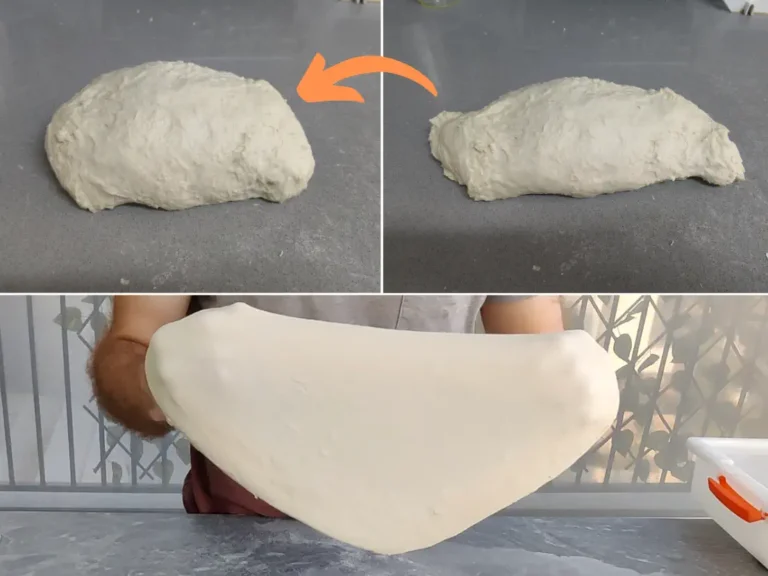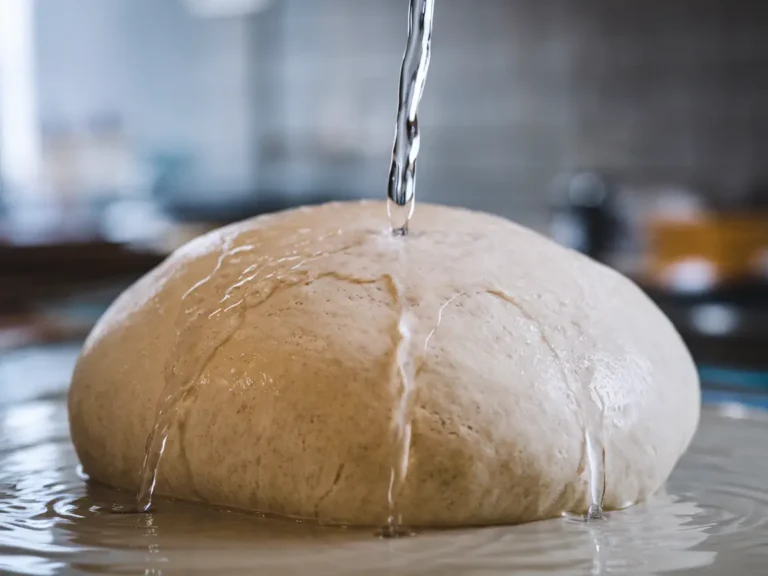What Is Pizza Flour? Understanding What Makes a Flour Suitable for Pizza (and Why There’s No One Best Flour)
In this article, we’ll explore what ‘pizza flour’ actually means: what makes a flour suitable for pizza-making, how different flours compare, whether there’s such a thing as the “best” flour for pizza, and how to choose the right one based on your needs
Introduction
Disclaimer: For clarity and ease of reading, this article has been excerpted from The Complete Guide to Pizza Flour (a recommended read), and focuses specifically on the topic of what is pizza flour.
If in the past we had a relatively limited selection of flours, today a quick stroll down the supermarket flour aisle reveals a vast array of options from different brands – some labeled specifically for pizza, others not – and it can be overwhelming to sort through them all. Pizza flour, bread flour, all-purpose flour – what’s the difference, and which one is best for making pizza?
The goal of this article is to help you make sense of the different types of flour available. Among other things, it will cover:
- What exactly is “pizza flour”?
- How different flours (pizza-labeled or not) differ from one another
- How flour affects the dough’s properties and the baked pizza
- How and why different flours suit different pizza styles, work processes, and goals.
But first, when discussing pizza flour, or flour in general, it’s important to understand the key characteristic that makes a flour suitable for making pizza and other baked goods: gluten.
Gluten: What It Is and How It Affects Dough and Pizza
For a more in-depth explanation on gluten and its role in baking, see Gluten in Pizza Dough Explained: Its Role, Importance, and Impact on Pizza.
Wheat flour contains two gluten-forming proteins, glutenin and gliadin, which make up 75–85% of the total protein content in white flour. When these proteins interact physically in the presence of water, they form chemical bonds, that we refer to as gluten bonds.
Gluten can also form spontaneously over time through a process called biochemical gluten development.
Wheat is unique in that it contains both a high quantity, quality, and the right ratio of glutenin and gliadin, enabling the formation of gluten bonds in both the amounts and qualities required for baking.
As we’ll see later, the quantity and properties of these gluten bonds vary between different flours, directly affecting the dough’s behavior and the final product.
Note that wheat, and therefore the flour made from it, does not inherently contain “gluten,” but rather gluten-forming proteins that can develop into gluten.
The gluten network gives structure, volume, strength, and elasticity to baked goods. Making a pizza or bread without gluten, is like trying to construct a building out of plastic bricks – it collapses the moment any stress is applied.
In the following sections, we’ll explore what gluten is, its characteristics and what affects them, and how all of this impacts both dough and pizza.
As noted earlier, flour doesn’t naturally contain “gluten”, but rather gluten-forming proteins. For simplicity, I’ll use the terms “gluten” and “protein” interchangeably throughout this article; So, when I refer to “flour with a high gluten content,” I mean flour that contains a high level of protein (gluten-forming proteins), and vice versa – “flour with high protein content” = flour with high gluten potential.
The Role of Gluten in Flour
The gluten bonds formed in dough made from wheat flour:
- Create a structure that balances elasticity and extensibility, providing strength, while allowing the dough to stretch and change shape without tearing.
- Enable the dough to hold its shape during fermentation and baking, preventing it from collapsing or spreading out.
- Allow the dough to trap gases produced by yeast activity during fermentation, which enables it to rise and expand in volume during fermentation and baking.
- Contribute to a proper internal crumb structure in the final product – defined, airy, and filled with air pockets of varying size and distribution, rather than being flat and/or dense.
Gluten-forming proteins can absorb up to twice their weight in water, and are responsible for about one-third of the flour’s total water absorption in the dough. As we’ll see later, the higher the (gluten-forming) protein content in a flour, the greater its water absorption capacity – allowing for higher-hydration doughs.
In short: Gluten gives the dough an elastic structure that allows gas cells to expand without tearing or collapsing, and enables the dough to rise, stretch, and hold its shape throughout fermentation and baking – resulting in the familiar qualities of well-made baked goods: good volume, and an airy crumb structure.
Gluten Quantity and Quality in Flour
Now that we understand what gluten is, let’s explore how both its quantity and quality affect flour and dough.
One of the main differences between various flours lies in the amount and composition (quality) of gluten they contain. These differences directly influence the dough’s properties and the final characteristics of the baked pizza.
Gluten Quantity in Flour
As discussed earlier:
- Gluten-forming proteins account for the majority (75–85%) of the total protein content in white flour.
- Gluten forms when these proteins interact in the presence of water and create gluten bonds.
Therefore, when it comes to white flour, a simple rule of thumb applies: The higher the protein content, the more gluten-forming proteins the flour contains – meaning greater potential to develop a strong gluten network and, in turn, a stronger dough structure.
A flour’s protein content can be determined by checking the nutritional label (protein per 100 grams):
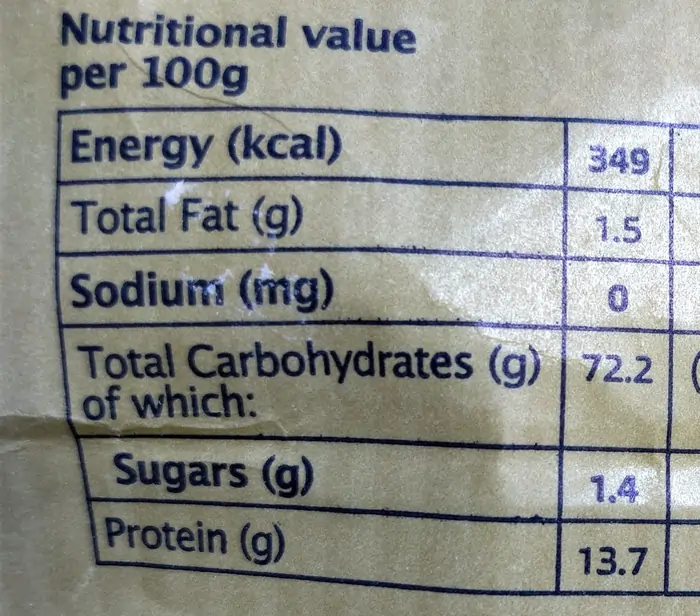
When we say “strong flour,” we mean flour with a high gluten-forming potential, usually indicated by a high protein content. One exception are Italian flours, which is often labeled using a different system called the W rating.
White flours generally range from about 8% protein (very weak flours, used for cakes and cookies) to over 14% (very strong flours). Most fall somewhere between 10.5% and 13%.
For pizza dough, depending on the pizza style, we usually want a flour with at least 10.5% protein.
There are two important exceptions: whole wheat flours and ancient/special flours.
Whole wheat flours often show a high protein content, but much of that protein comes from the bran and germ, and is not from gluten-forming proteins. These non-gluten proteins don’t contribute to gluten development, and may even hinder it (we’ll cover this in more detail later).
“Ancient” or “special” flours, such as rye, spelt, and khorasan, may also appear high in protein, but their gluten-forming proteins differ significantly from those in regular white wheat flour. As a result, they generally don’t produce a strong enough gluten network for pizza dough.
In summary: For white wheat flour, higher protein content usually means a stronger flour, leading to a more elastic and resilient dough.
However, protein quantity alone doesn’t tell the whole story, which brings us to the importance of gluten quality.
Gluten Quality in Flour
While a flour’s protein content indicates its potential to develop gluten, the quality of that gluten is just as important. This quality depends largely on the specific composition of the gluten-forming proteins in the flour, or more precisely – in the wheat from which it was milled.
Flours milled from different wheat varieties, or processed in different ways, can have the same protein content, but vary significantly in protein quality. As a result, they can produce very different gluten structures.
Remember that in white flour, 75–85% of the total proteins are gluten-forming, depending on the wheat variety used. This means that two flours with the same total protein content may contain different amounts of gluten-forming proteins – directly influencing the flour’s gluten quantity, strength and behavior.
In both theory and practice, two flours with identical protein content can form completely different gluten structure – each varying in strength, density, and elasticity/extensibility properties (discussed in the next section). For example, a high-protein flour with poor gluten quality may perform worse than a lower-protein flour with high-quality gluten-forming properties.
A good example is durum wheat flour. While rich in gluten-forming proteins, its unique protein composition results in short gluten strands. This creates a very elastic and compact gluten network, which makes the dough strong but stiff and less extensible – typically unsuitable for pizza (but very suitable for pasta).
Other examples include “special” flours like rye and spelt, and “ancient” flours such as Khorasan and Emmer. Even when these flours match regular white wheat flour in protein content, their fundamentally different gluten protein compositions lead to weaker, less elastic gluten structures – generally making them a poor choice for pizza-making.
So, while a flour’s gluten-producing potential can be roughly estimated by its protein content, assessing its gluten quality is less straightforward.
Unfortunately (or fortunately), the only reliable way to evaluate gluten quality is through trial and error. Technical data can help, but the true behavior of the gluten only becomes clear when you actually work with the flour.
Flour mills do use a metric called the Gluten Index (GI) to assess gluten quality. This index ranges from 0 to 100, with higher values indicating stronger, more resilient gluten. However, GI values are rarely made publicly available, and must typically be requested directly from the mill.
In conclusion: While protein content is a useful indicator, the quality of that gluten plays a critical role in how the flour performs, and ultimately in the strength, elasticity, and extensibility of the dough.
The Elasticity and Extensibility Properties of Gluten in Flour
For an in-depth read on extensibility and elasticity in dough, see Dough Elasticity and Extensibility: Understanding the Two Most Important Properties in Pizza Dough (highly recommended).
Different flours are milled from different wheat varieties, each containing varying ratios of the gluten-forming proteins glutenin and gliadin. This ratio determines whether the resulting dough will be more extensible (stretches and holds its new shape) or more elastic (resists stretching and snaps back to its original form).
A flour’s extensibility and elasticity properties can be considered key aspects of its gluten quality.
These properties also influence the dough’s overall structure and the texture of the baked pizza – more on that in the article linked above.
Each wheat variety naturally has its own balance of glutenin and gliadin, which directly affects the flour’s behavior:
- A higher ratio of glutenin → More elastic dough: strong, tight, and resistant to stretching.
- A higher ratio of gliadin → More extensible dough: softer, stretchier, and easier to shape.
Durum wheat flour, for example, is very elastic – it’s strong and “hard,” resisting stretching and forming a dense gluten network. Spelt flour, on the other hand, is highly extensible and produces a relatively weak, soft, and stretchy dough. In both cases, the balance between extensibility and elasticity is not ideal for pizza dough: overly elastic dough resists stretching and tends to snap back, while overly extensible dough lacks strength, stretches too easily, and risks tearing due to lack of structure.
One of the key features of Italian flours, particularly those designed for pizza, is their extensibility/elasticity ratio. These flours are typically more extensible, making the dough easier to stretch and shape without tearing or snapping back.
For most pizza dough, the goal is a balance between elasticity and extensibility, with a slight lean toward extensibility:
- The dough should stretch easily without springing back or tearing (sufficient extensibility).
- It should also hold its shape during fermentation and baking without collapsing (sufficient elasticity).
As we’ll see later, different pizza styles may call for different elasticity/extensibility profiles. What works well for one type of pizza may not suit another.
While most flours labeled as “pizza flour” are formulated to have a suitable extensibility/elasticity ratio for pizza-making, many other flours naturally offer a good balance as well – even if they aren’t specifically marketed “for pizza”.
The elasticity and extensibility properties can be measured in a lab using devices like the alveograph and extensograph, which evaluate dough strength and stretching behavior; But, as with gluten quality, the most practical and reliable way to assess a flour’s performance is through hands-on experience and trial and error.
Gluten and the Flour’s “Resistance” to Fermentation
The relationship between flour and fermentation time is discussed in greater depth here. This section provides a general overview of how both the quantity and quality of gluten influence a flour’s resistance to fermentation.
During fermentation, the dough undergoes processes of rising and ripening that significantly affect its structure.
One key factor during fermentation is the activity of protease enzymes, which are naturally present in flour.
Protease enzymes gradually break down gluten bonds as fermentation progresses. Generally, the longer the fermentation, the more time protease enzymes have to act, weakening the gluten network and softening the dough until it eventually reaches a point of over-fermentation.
While protease activity is generally beneficial and desirable, excessive breakdown of gluten can lead to a dough that is weak, sticky, overly extensible, difficult to handle, and produces poor baking results.
So how does this connect to flour choice? The answer is straightforward: The more gluten a flour contains, and the higher the quality of that gluten – the more resistant it will be to fermentation.
The logic is simple: assuming all things being equal, a flour that starts with a higher amount or stronger gluten will retain more structure by the end of fermentation, and remain more workable and stable throughout the process.
The video below shows the fermentation performance of three different flours over 12 hours. Notice how the dough on the left collapses and loses its structure much sooner than the others (about 7 hours in), demonstrating lower resistance to fermentation.
In summary: As a rule of thumb, the more gluten a flour contains, and the higher its quality, the better it resists fermentation. This helps the dough maintain its structure and shape during fermentation and baking, preventing collapse and poor baking results.
Classification of Flour “Strength” by Protein Content
Here’s a general guide to classifying flour strength based on its protein content (per 100 grams):
- Up to 10.5%: Low protein content. Weak flour that is not suitable for making pizza. Typically used for cakes, cookies, and sweet pastries.
- 10.5–11.5%: Medium protein content. Medium-strength flour. Suitable for most types of pizza.
- 11.5–13.5%: High protein content. Strong flour. Well-suited for nearly all styles of pizza.
- 13.5% and above: Very high protein content. High-gluten, very strong flour. Generally not ideal for pizza when used as the sole flour in a dough (too elastic on its own).
This is a broad classification. As discussed earlier, gluten quality can influence flour strength as much, or even more, than gluten quantity.
Bonus: How to Determine the Gluten Quantity and Structure of Flour at Home (Gluten Ball / Wash Test)
If you’d like to evaluate or compare the amount and characteristics of gluten in a specific flour, you can perform a simple at-home experiment known as the Gluten Ball Test (also called gluten wash test).
You can find the full test protocol here.
The test involves making a small dough ball, weighing it, and then “washing” it under running water to remove the starch (which is water-soluble) until only gluten and water remain. Since gluten-forming proteins are not water-soluble, they remain intact in the dough.
The result is a rubbery mass known as wet gluten, which you weigh and compare to the weight of the original dough ball. This gives you the wet gluten content of the flour. Typical wet gluten yields range from:
- ~20% of the original dough weight: Very weak flour
- ~35% or more: Very strong flour
You can repeat the test across different flours to compare their relative gluten-forming potential.
Note that the results of the gluten ball test are comparative, not absolute. They depend heavily on how consistently the test is performed. As long as the method is the same for all flours tested, the results can reliably show differences in gluten quantity between flours.
You can also take this test a step further by baking the wet gluten ball in the oven. This produces a dry gluten ball, allowing you to visually assess the structure and quality of the gluten formed by each flour.
In the image below, you can see two wet gluten balls from different flours, alongside their corresponding dry forms after baking.
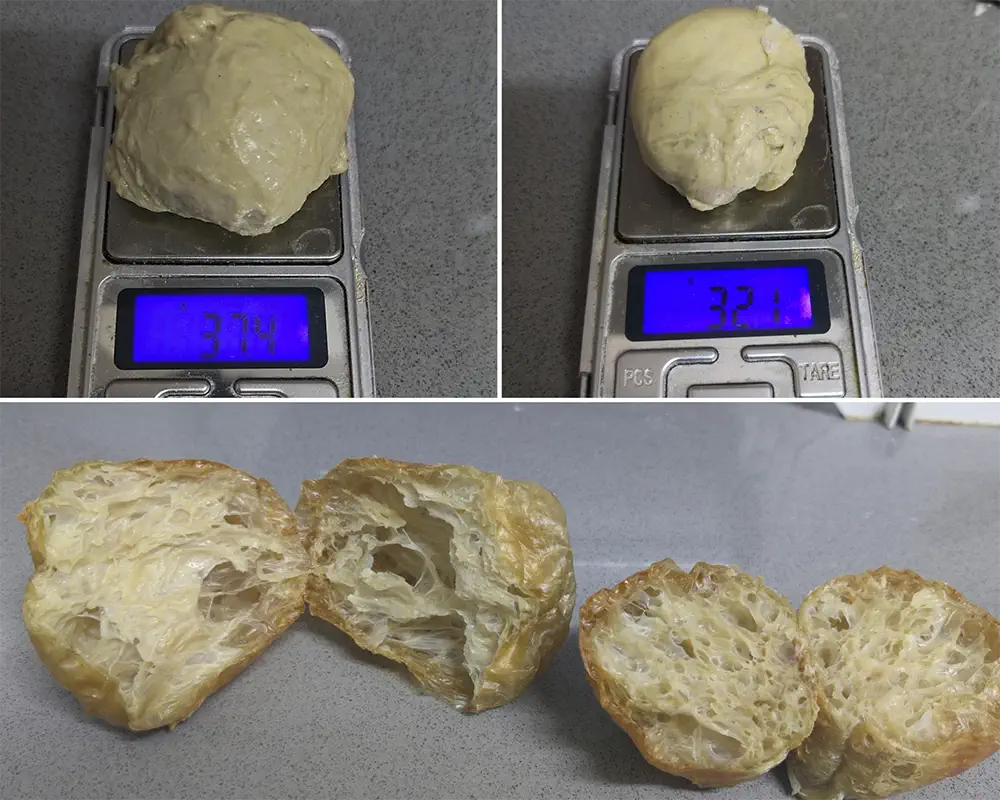
In the next image, you can see a gluten ball made from Caputo Chef/Cuoco flour. Although its wet gluten content is similar to the previous example (about 25.5%), the structure is noticeably different – much more ‘delicate’ and open.
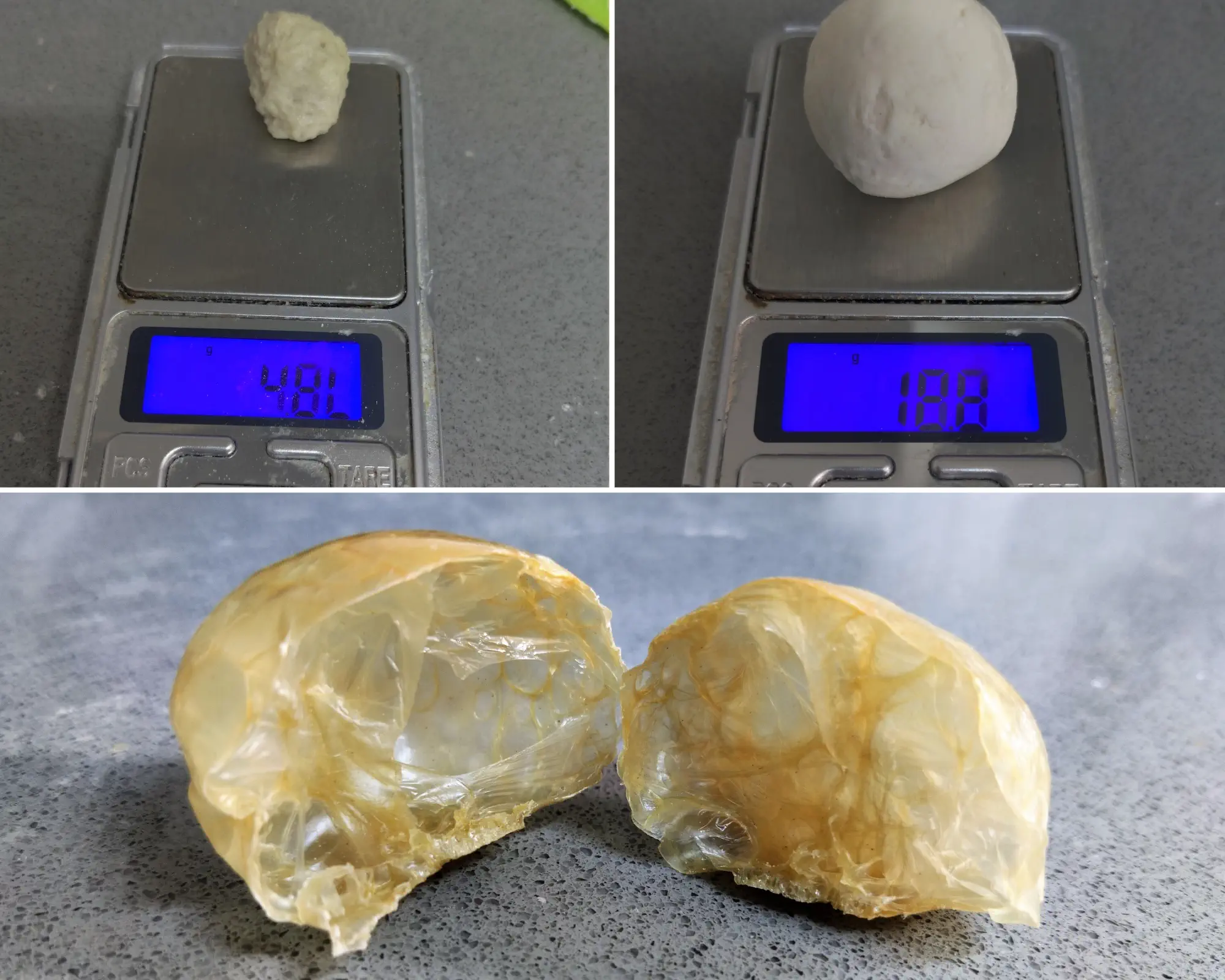
Characteristics of Flour Suitable for Making Pizza [Quick Summary]
Here is a brief overview of the essential characteristics of flour for making pizza:
- Adequate protein content and gluten quality: The flour should have a protein content on the higher side (at least 10.5%), and form good-quality gluten.
- Structural integrity during fermentation: The dough should maintain its shape and structure without collapsing or becoming overly sticky and difficult to handle.
- Workability and stretchability: The dough should be easy to stretch into a pizza base, with a balance of extensibility to elasticity, so it doesn’t stretch too easily, resist too much, or tear during stretching.
- Gas retention and crumb development: The dough should effectively trap fermentation gases, producing an open, airy internal crumb with well-formed air pockets.
Note that while flour plays a major role in all of these aspects, the fermentation process often has an even greater influence on the final results.
What Is the Difference Between Different Flours for Making Pizza (or Any Other Baked Goods)
So, what are the actual differences between flours in the context of pizza?
In practice, there is a wide variety of flours suitable for making pizza. Any flour that meets the criteria outlined in the previous sections, regardless of whether it’s labeled as “pizza flour”, can produce excellent results.
Two key factors distinguish different flours:
- The content and quality of protein (gluten-forming proteins)
- The extensibility/elasticity ratio (a component of overall gluten quality)
Although these are “just” two factors, they can dramatically change how the flour behaves. This is the core distinction between flours – whether for pizza or other baked goods – and applies across brands or even different types of flour from the same manufacturer.
While flours labeled as “pizza flour” are generally optimized for these characteristics, many bread flours, all-purpose flours, and even all-purpose flours can also be well-suited for pizza.
Here are some general examples to illustrate how different flours can affect the dough and the baked pizza:
- Two flours with the same gluten content but different gluten quality can produce very different doughs in terms of strength, handling, and final structure.
- Doughs made with different flours can vary widely in elasticity and extensibility. Some may snap back aggressively when stretched, while others may yield more easily and allow for thinner, more even stretching without tearing.
- Stronger flours generally offer more resistance to over-fermentation, while weaker flours may collapse or lose structure more easily during long fermentation.
- Variations in gluten structure and elasticity/extensibility properties also influence the final baked result: from differences in volume (tall vs. flat) to crumb texture (airy vs. dense).
- Many flour producers adapt the gluten characteristics, both quantity and quality, for specific applications. For example:
- Flours optimized for long fermentation typically have stronger gluten structures, while those intended for shorter fermentation times are generally weaker.
- Flours may be tailored for different pizza styles: a flour suited to thin, hand-stretched pizzas needs higher strength and extensibility, whereas a pan-baked pizza may require less of both.
- Some flours are designed for occasional home bakers, prioritizing ease of handling and shaping over high-performance dough characteristics.
- Different flours are suited to different pizza styles and baking needs (more on that in the next section).
- Other flour characteristics, beyond just gluten content and behavior, also influence dough handling and pizza quality.
While flour choice significantly influences dough behavior and baking results, these outcomes depend just as much – if not more – on the entire pizza-making process: kneading, fermentation, and baking.
In summary: The main differences between flours lie primarily in the amount and quality of gluten and the extensibility/elasticity ratio – key properties that directly influence dough behavior, ease of handling, and the final baked result.
Some flours also include dough conditioners/improvers designed to adjust their natural strength, extensibility and elasticity.
For example: If a flour naturally produces a very extensible dough, additives (like ascorbic acid) may be included to strengthen the gluten network and increase elasticity; Conversely, if a flour is naturally very elastic and strong, dough reducers (such as L-cysteine) may be added to soften the dough, making it more extensible and easier to work with.
Different Flours for Different Types of Pizza and Applications (Is There a “Best” Flour?)
Now that we understand how flour properties affect dough and the final result, it’s important to recognize that not all pizzas are created equal, and that different pizza styles often require flours with distinct characteristics.
For instance, Chicago deep dish dough is entirely different from New York style or Neapolitan dough, and therefore calls for a different type of flour. Likewise, thick doughs baked in a pan require different handling – and flour – compared to thin pizzas that are hand-stretched.
Below are some general examples of popular pizza types and the flour strength they typically require (based on protein content):
- Neapolitan Pizza [Classic]: Hand-stretched to a thin base. Requires medium-strength flour. Typically made with medium-strong Italian flours or non-Italian all-purpose flours with medium protein content.
- Modern Neapolitan Pizza (“Canotto Style”): Features a big crust and a very open and airy crumb structure. Requires strong flour. Typically made with very strong Italian flour or strong non-Italian flour. Often paired with a preferment.
- New York Style Pizza: Thin, hand-stretched crust. Requires medium-strong flour. Typically made with bread flour.
- Detroit Style Pizza, Sicilian Pizza: Thick, pan-baked dough. Requires medium-strong flour.
- Midwest/Bar-Style / Cracker-Style Pizza: Dough is rolled or hand-shaped and often pan-baked. Requires medium-strong flour.
- American-Style Pizza (Generic): A generic, pan-stretched and baked pizza. No special flour characteristics are needed – most pizza-appropriate flours will work.
- Chicago Deep-Dish Pizza: More similar to a pie crust dough than traditional pizza dough. Requires weak flour.
Flour, and specifically its elasticity/extensibility properties, also affects the final baked result. For example, a highly extensible flour with strong gluten-forming potential can produce a crust with more volume and a lighter, airier crumb. In contrast, flour with “simpler” gluten properties will yield a more compact dough with less oven spring. For more on this, see Dough Elasticity and Extensibility: Understanding the Two Most Important Properties in Pizza Dough.
To conclude this section, it’s important to emphasize that there’s no such thing as “better” or “worse” flour – only flour that is more or less suitable for a specific use. One baker might aim for maximum volume and an open structure, while another may have entirely different goals. The ideal flour depends on the application and the outcome you want to achieve.
In summary: Your flour choice should match the style of pizza you’re making and the characteristics you’re aiming for. What works perfectly for one type of pizza, may perform poorly for another.
“Pizza Flour” – a Marketing Term?
Now that we’ve covered how different flours vary and what makes them suitable for pizza, a natural question arises: is the label “pizza flour” mainly a marketing tactic?
The answer is both yes and no.
On the one hand, flours marketed as “pizza flour” usually do have properties that make them well-suited for pizza-making, such as a sufficiently high gluten content & quality, and a good balance between elasticity and extensibility.
However, many other flours with similar characteristics aren’t labeled as “pizza flour”, and can deliver equally excellent results. A good example is bread flour, which often shares the same functional traits.
Most bread flours are strong enough to support long fermentation and maintain their structure, with an elasticity/extensibility ratio that allows for easy shaping. Their gluten quality is typically high and enables a good volume and an airy internal structure – features that are desirable in most types of pizza. As a result, many bread flours are excellent choices for pizza baking.
“Bread flour,” like “pizza flour,” is a vague and unregulated term. There are no specific industry standards a flour must meet to be labeled as “bread flour” – it’s purely a branding decision made by the manufacturer. As with “pizza flour,” bread flours can vary widely in strength, gluten quality, and elasticity/extensibility characteristics. In practice, a “multi-purpose” flour from one producer may perform better for pizza or bread than a “bread flour” from another.
It’s not uncommon for a manufacturer to introduce a new line, or expand an existing one, with a “pizza flour” – even if it closely resembles other flours in their catalog. Often, this new label comes with a higher price point, and is designed to position the product as a more “specialized” or “professional” option; But in many cases, the actual differences are minimal, and the rebranding is simply a way to increase profits or tap into niche markets.
This isn’t limited to pizza flour. Other examples include flours labeled for specific uses like “focaccia flour” or “baguette flour,” which often have very similar properties to standard bread or pizza flours. The main exception is flours made specifically for cakes or cookies, which are intentionally weak in gluten and unsuitable for pizza or bread.
In summary: Flours labeled as “pizza flour” are generally suitable for making pizza, but the marketing aspect plays a significant role. Much of the “specialized” branding is part of a business strategy, and many of these flours – whether from the same manufacturer or another – may be equally well-suited for pizza making, even if don’t carry the “for pizza” label.
Summary: What Is “Pizza Flour,” and How Do You Choose One?
To begin with, “pizza flour” is any flour that meets the functional criteria described earlier – regardless of whether it’s officially marketed or labeled as such.
A flour suitable for pizza-making should have good gluten quantity and quality, along with a well-balanced ratio of extensibility to elasticity. This allows the dough to be easy to work with – not too slack, not too tight, and results in a defined, airy internal structure with good volume.
The specific flour characteristics you need depend on the type of pizza you’re making, your desired outcome, and your dough-making process. Many flours, whether marketed as “premium” or “budget,” can meet your needs. The only way to find the “best” flour for your specific process, pizza style, and personal preferences – is through experimentation.
There is no universally “best” flour. Some flours will perform better or worse under certain conditions, and those conditions vary between individuals, techniques, and recipes. You might find that a particular bread or pizza flour works best for you, or that a generic, unbranded, “all-purpose” flour does the job just as well. In this context, price is not a reliable indicator of quality or suitability.
Likewise, someone else’s recommendation for flour X may not apply to you. How the flour is used makes all the difference, and the only way to understand how a flour behaves is to test it in your own process.
Finally, while flour choice is important, proper fermentation is equally – if not more – critical to producing great results. Using a “premium” or “professional” flour won’t magically improve your pizza, just as a football player won’t play better simply by wearing expensive shoes.
Flour can help you reach specific goals, and some flours might serve as helpful “training wheels” for less experienced bakers. But ultimately, flour is just the canvas – the real impact comes from the baker’s knowledge, technique, and experience.
Enjoy the content on PizzaBlab? Help me keep the oven running!


